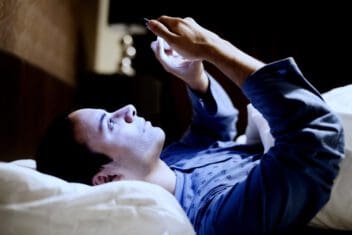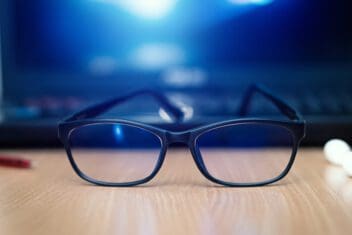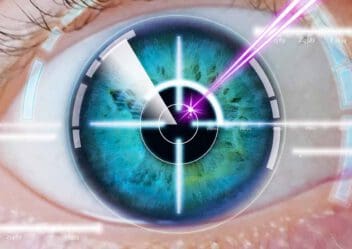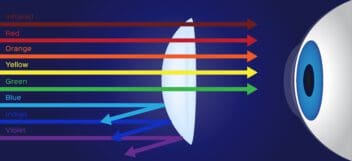
Medically Reviewed by Lee R. Katzman, M.D.
Facts, Statistics & Myths About ‘Blue Light’
Home / Vision Education Center /
Last Updated:

Medically Reviewed by Lee R. Katzman, M.D.
Studies on blue light suggest that newer types of light bulbs and increased use of digital devices have led to more exposure to this wavelength. This exposure could increase risks to vision, metabolism, and sleep.
Table of Contents
Too much blue light has been linked to poor sleep and metabolism changes from changed circadian rhythms, as well as damage to the retina over time. Blue light studies are still small and inconclusive, so there is little solid information about how bad too much blue light can be.
Blue light does have some benefits. It is important for mood, alertness, and thinking.
You may benefit from managing how much blue light you are exposed to, especially through digital devices.
Blue Light: Several Impacts on Health, Both Good & Bad

Different wavelengths of light affect our vision and eye health differently, including wavelengths like ultraviolet that we cannot see. Indoor lighting is becoming more complex, and electronic devices use backlighting to make onscreen words and images easier to see.
These changes in our exposure to certain types of light from various sources are beginning to change our health. Exposure to a specific wavelength called blue light — which emanates from some types of LED lights, computer screens, and mobile devices like phones — appears to be affecting our overall health, including our visual health.
You deserve clear vision. We can help.
With 135+ locations and over 2.5 million procedures performed, our board-certified eye surgeons deliver results you can trust. Your journey to better vision starts here.
Sunlight naturally contains several “colors” of light, which is a way scientists describe different wavelengths in the visible, and just outside the visible, spectrum. Red, orange, yellow, green, and blue light waves are the most common in the visible spectrum.
Colors describe the amount of energy in each part of the spectrum. When combined, the light spectrum creates “white light,” which we experience with regular, midday sunlight.
With the rise of LED lights and electronic devices, more of us are exposed to the blue spectrum of light on a regular basis. This may cause problems with sleep habits, metabolism, and visual acuity. It could even lead to macular degeneration.
There are several myths about how dangerous blue light is. Exposure to this wavelength is important for our overall health too. There are things you can do to protect yourself from blue light’s actual risks.
Potential Harm From Too Much Blue Light
Sunlight is the main source of blue light, but as more of us use laptops, flat-screen televisions, tablets, and smartphones, we increase our exposure to blue light that mimics daylight. Fluorescent lights and some types of LED lightbulbs also emit higher levels of blue light compared to incandescent bulbs.
The eye is not good at blocking blue light. Some structures in the eye, like the cornea, iris, and lens, are much better at blocking ultraviolet light or some other harmful wavelengths. Even without UV sunglasses, only about 1 percent of UV light hits the retina. In comparison, most blue light reaches the back of the eye.

A specific type of blue light called high-energy visible light (HEV light) is emitted by electronic devices. The amount of rays coming from this kind of light is still lower than the amount emitted by the sun on a cloudless day.
Blue light in sunlight appears to be tied to parts of our sleep cycle and metabolism. Health researchers are concerned that an increase in exposure to this wavelength of light could increase rates of insomnia and weight gain.
Digital eye strain may be associated with blue light. According to some eye doctors, exposure to this type of light could increase the risk of macular degeneration later in life. If you have had cataract surgery and now have an artificial lens, you could be at higher risk for problems associated with blue light, and you benefit from special blue light-filtering glasses.
The advent of blue-light-emitting technology is relatively recent, so there are few medical studies on long-term problems like chronic insomnia, metabolic diseases, and eye diseases. Certain eye problems are associated with too much blue light exposure.
- Digital eye strain: Spending a lot of time staring at a computer screen can hurt your eyes, leading to blurry vision, dry eyes, and discomfort or pain. People who use computers for work, communicate frequently using a smartphone, or use electronic devices for several hours throughout the day may not blink as often as they need to because of the screen’s flickering. Another source of strain may be too much blue light.
- Retinal damage: Studies have suggested that exposure to too much blue light can damage your retina, which leads to poor central vision and low vision.
- Age-related macular degeneration: Exposure to blue light could damage photoreceptor cells on the retina. Over time, compounded retinal damage leads to central vision loss. It can sometimes lead to retinal detachment.
Links to Other Risks
A study published in Scientific Reports examined the effects of blue light on the molecule retinal and its toxic harm to photoreceptor cells and damage to the retina. These photoreceptor cells do not regenerate after being destroyed. This kind of damage can accelerate macular degeneration, which is one of the top causes of blindness in the world.
While retinal does appear to have toxic effects on the eyes, the study does not offer indisputable proof that blue light and smartphone use will actually speed up or lead to blindness.
The study was run in a lab and not on actual eyes, so the toxicity and potential for blindness from blue light is still not clear, Forbes explains.
Busting the Myths Around Blue Light
Some medical studies have indicated that exposure to blue light at night can change your circadian rhythm and make it hard to sleep. Studies on sleep loss have associated chronic insomnia and poorly regulated circadian rhythms due to shift work, consistent travel, and other major changes with serious health risks like diabetes, heart disease, obesity, and cancer.
There is no direct link between chronic health problems and exposure to blue light at night. Studies conducted by medical researchers have been small in scale, so they are not considered conclusive. While lack of sleep is associated with long-term poor health, using your phone a bit right before you go to bed will not likely cause a lifetime of health problems.
Medical studies involving sleep loss, health problems, and light exposure include the following:
- A Harvard medical study involving only 10 participants found that changes to circadian rhythm led to increased blood sugar and lower levels of leptin, the hormone that helps you feel full after you eat.
- A different Harvard sleep study measured exposure to 6.5 hours of blue light to a similar amount and brightness of green light. Blue light inhibited melatonin production, a hormone that helps induce sleep, for twice as long as green light exposure. This altered circadian rhythms more — 3 hours for blue light compared to 1.5 hours for green light.
- A Harvard sleep specialist reports that exposure to light at night reduces the quality of your sleep, but this covered all types of light, not just blue light.

Reducing how much time you spend using electronic devices can help you to manage your sleep cycle. However, it is only one of several factors that impact how restful your sleep is.
Since studies about the impact of blue light, often from digital devices, began appearing, many news stories have frantically suggested that blue light can cause blindness. Researchers at the University of Toledo (UT) found that body cells, including photoreceptor cells in the retina, could be killed by blue light. In comparison, red, yellow, and green light did nothing to these cells.
The research team added that vitamin E could protect against this problem. As we age, we are less able to metabolize vitamin E, and our immune systems become suppressed, so our ability to fight blue light’s damage goes down. This may suggest a link between age-related macular degeneration and blue light exposure, but it is still nothing to worry about during young adulthood and middle age.
You deserve clear vision. We can help.
With 135+ locations and over 2.5 million procedures performed, our board-certified eye surgeons deliver results you can trust. Your journey to better vision starts here.
Blue Light Is Also Good for You
Exposure to blue light is important for our brain chemistry and overall health, so constantly blocking sources of this light could be detrimental. Studies on the effects of blue light have found it can:
- Boost attentiveness.
- Help you feel more awake.
- Improve memory.
- Improve cognition.
- Elevate mood.
People who have seasonal affective disorder (SAD), a form of depression that typically becomes worse during the winter months, often use blue light therapy to ease their symptoms. Specialized light therapy boxes emit a significant amount of HEV rays, so people with SAD feel like they have had more exposure to regular sunlight.
While too much exposure to blue light may trigger insomnia in some people, not enough exposure may lead to the opposite problem and continue to deregulate the sleep cycle. Living in more northern latitudes with shorter winter days means you have much less natural exposure to blue light. Using electronic devices will not compensate for HEV light missing from your daily routine in some places.
Children who are not exposed to enough blue light may suffer poor eye development and visual acuity. One study suggests that too little exposure to blue light (usually from less time spent outdoors) could contribute to the global increase in nearsightedness.
Managing Your Exposure to Blue Light Is Helpful

If you need to use laptops, flat-screen televisions, tablets, e-readers, and smartphones consistently, you may worry that you are exposed to too much blue light. Getting natural sources of blue light will also increase your exposure to other wavelengths of light, which can be better for you overall. Finding ways to take care of your eyes indoors will also help your overall health.
Some smart devices have built-in blue light filters. You can also use apps or device settings to reduce the backlight or glare from the device, which can lessen how much blue light your eyes absorb.
Your optometrist can help you decide if you need blue-light-filtering lenses on your next glasses prescription too. Several manufacturers make lenses with antireflective or anti-glare coating, which reduces sources of eye strain if you often use electronic devices.
You can limit how much time you spend using digital devices, especially at night. The Centers for Disease Control and Prevention (CDC) recommends creating a routine at night to help you get regular sleep, and one step is to stop using devices that emit blue light two hours before going to bed. If you have sleep troubles, remove these devices from your bedroom so you are less tempted to use them while in bed.
You deserve clear vision. We can help.
With 135+ locations and over 2.5 million procedures performed, our board-certified eye surgeons deliver results you can trust. Your journey to better vision starts here.
References
- Why Blue Light Is So Bad: The Science and Some Solutions. (July 2018). Medium.
- Blue Light Has a Dark Side. (August 2018). Harvard Health Publishing, Harvard Medical School.
- Blue Light Hastens Vision Loss? “Not So Fast,” Doctors Say. (August 2018). American Optometric Association (AOA).
- Blue Light Excited Retinal Intercepts Cellular Signaling. (July 2018). Scientific Reports.
- Is Blue Light From Your Smart Phone Harmful to the Eyes? (August 2018). Forbes.

Originally from New York, Lee R. Katzman, M.D. is a board certified Cornea Specialist and active Fellow of the American Academy of Ophthalmology.He has performed thousands of refractive surgical procedures and has been honored with numerous San Diego Top Doctors awards.
This content is for informational purposes only. It may have been reviewed by a licensed physician, but is not intended to serve as a substitute for professional medical advice. Always consult your healthcare provider with any health concerns. For more, read our Privacy Policy and Editorial Policy.